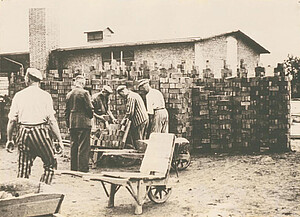
Concentration Camp
At the end of 1938, the SS established a satellite camp of the Sachsenhausen concentration camp in an abandoned brick factory in the Neuengamme suburb of Hamburg. In the early summer of 1940, Neuengamme became an independent camp, and it remained the main concentration camp in north-west Germany until 1945. During the war, the Gestapo (secret state police) and the SS security service sent tens of thousands of people from across occupied Europe to Neuengamme concentration camp. Most were imprisoned because they had resisted German occupation, because they had refused to perform slave labour, or because they were victims of racial persecution.
In Neuengamme concentration camp and its more than 85 satellite camps, which were established all over northern Germany for construction projects and armaments production, prisoners had to do hard labour for the war economy. Living and working conditions were murderous. Altogether, at least 42,900 people died in the Neuengamme main camp and satellite camps, or they died on the death marches when the camps were evacuated or when the prisoner ships were bombed. Another several thousand prisoners died after they were transported from Neuengamme to other concentration camps, or they perished after the war from the results of incarceration.
“It was as if we’d landed on another planet. It was a place of extreme terror. My friend who was arrested together with me – I was seventeen, he was twenty – told me when he arrived: ‘I won’t survive this more than three months.’ And indeed, three months later, he was dead.”
Georges Jidkoff from France was imprisoned in several camps, including the Neuengamme satellite camp Salzgitter-Watenstedt from May 1944 to April 1945. (Interview, 31 January 1987, ANg)

